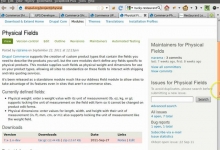

Familiarizing new users with Drupal is out of scope for this documentation, so we recommend using other freely available resources to get up and running on Drupal 7 before installing and configuring the Commerce modules. With the release of Drupal 7, navigating the backend is easier than ever, but there's still quite a lot to learn. See Installing Drupal Commerce for more details.īuilding a Drupal Commerce site is easiest when you have at least some familiarity with administering Drupal itself. It's very important to get the right set of modules turned on and a number of configurations need to be setup for content types and custom entities.

Note: This user guide assumes that you are working with Commerce Kickstart 1.x or that you are familiar with Drupal.

Checkout completion - Create subscriptionsīuilt with Grav - The Modern Flat File CMS.Overriding Payment Gateway configuration.Installing and Configure a Payment Gateway.Displaying quantity on add to cart form.Adding images to variations and dealing with image styles.Adding a taxonomy field to a Product for Attributes.Setup Product Catalog using Views, Taxonomy, and Menu.Troubleshooting the Kickstart 2 Installation.Creating orders with the Drupal Commerce API.Writing SimpleTests for Commerce modules.Instantiating core forms in contributed modules.Function that tells us if the items in Shopping Cart / Basket.Calculating Flat Rate Based on Customer’s Shipping Address.Configuring / Creating Customer Profiles.Implementing an automated order workflow.Direct Payment Methods (Invoices, Deferred Payments).Modifying the Shopping Cart using Views.Product Pricing Rules (with screencasts).Choose the address component to work with.
#DRUPAL COMMERCE CONFIGURATION INSTALL#
If you're using the Commerce Kickstart install profile, you'll probably have just one option here, "Address". Choose line-item:order as the data selector.Select the "Order Address Component Comparison" condition.Note that there are no conditions yet (because the default is a tax that's always applied).That lets you have direct access to the rule that will control this tax. Click "configure component" next to your new tax. After creating the tax, you'll be on the Taxes page again.Let's use a sales tax, a Colorado State Sales Tax of 4.3% (.043).
#DRUPAL COMMERCE CONFIGURATION HOW TO#
There are other applications, but we'll demonstrate how to do it based on order address: Most of the time, we'll be applying different taxes based on the location of the buyer. It uses the Rules engine to allow you great power. Drupal Commerce, though, is up to the task. Unfortunately, the world is not set up to allow us to do simple taxes all the time, and we end up needing rules for them. An extra 10% subtotal line item will be added to every order Conditional Taxes Visit the tax rate configuration at Administration -> Store -> Configuration -> Taxes (admin/commerce/config/taxes) and add a tax rate.įor example, to add a sales tax of 10%, I can click "Add a tax rate", fill in the form, put a rate of 0.10, and that's all there is to it. If you have a tax which is added to every order without any complex rules, there's nothing to it. In VAT, the total shown to the customer already includes the tax, and nothing is added in the subtotal section (although Drupal Commerce does itemize the tax portion of the total.)



 0 kommentar(er)
0 kommentar(er)
